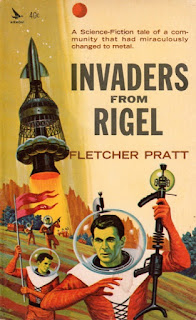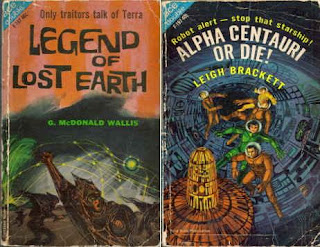Ace Double Reviews, 11:
War of the Wing-Men, by Poul Anderson/
The Snows of Ganymede, by Poul Anderson (#D-303, 1958, $0.35)
Here's an interesting pairing of early Poul Anderson novels. One is the very first story, as far as I can tell, about the Polesotechnic League; and also the first Nicholas van Rijn story. The other is an obscure short novel about his OTHER "P" league, the Psychotechnic League. The Polesotechnic League stories are in many ways a celebration of free-market capitalism and at least a quasi-libertarian (small-l) world view. By contrast the Psychotechnic Leagues stories seem to promote a technocracy, with secret masters controlling humankind for our own good, and with psychological knowledge developed to the point that the human race can partly be cured of its maladies such as war. In this context it is interesting the that Psychotechnic League stories almost all predate the Polesotechnic League stories -- the only potential exceptions are the 1968 novelette "The Pirate", which I do not remember, and the 1959 novel
Virgin Planet, which the ISFDB lists as a Psychotechnic League novel, but which seems to have at best a tenuous link to that series. (Certainly it does not foreground the technocratic themes of stories like "Un-Man".)
 |
| (Covers by Ed Emshwiller and Ed Valigursky) |
It should be noted that in both series some ambiguity as to the likely virtues of the political/social systems involved creeps in.
The Polesotechnic League story, of course, is
War of the Wing-Men. This is a novel of roughly 50,000 words. It was serialized in early 1958 in
Astounding as "The Man Who Counts". It was reprinted as
War of the Wing-Men in some later Ace editions, but in 1978 it was republished as T
he Man Who Counts, both in itself by Ace and as part of the big Berkley collection
The Earth Book of Stormgate. So that title, not surprisingly, must have been Anderson's choice. I've done a cursory comparison of the Astounding serialization and the Ace Double printing, and they appear to be essentially identical, save a few words changed presumably by one editor or the other ("tensed" for "tautened" is one example). The Psychotechnic League story is
The Snows of Ganymede. This is only some 30,000 words long, and was originally published in the Winter 1955 issue of
Startling Stories. Again, I've compared the two texts and they seem to be identical.
War of the Wing-Men is set on Diomedes, a somewhat unusual planet. One of the important features include considerable size (twice the diameter of Earth) but very low density (because there are no heavy metals), leading to a combination of gravity and air pressure that makes flight possible for fairly large animals. Another key feature is an axial tilt of nearly 90 degrees, meaning that for much of the planet the sun never rises in winter and never sets in summer. The upshot is that the intelligent natives are winged, have a technology that must do without metal, and generally need to migrate seasonally.
 |
| (Cover by H. R. Van Dongen) |
Nicholas van Rijn, a "merchant prince" of the Polesotechnic League, has come to Diomedes to check on his trading post there, which is run by Eric Wace. They are accompanied by Sandra Tamarin, the Crown Princess of the planet Hermes. (Need I mention that she is a tall, busty, face too strong to be beautiful, r/e/d/h/e/a/d/ er - blonde?) As the action opens the three of them are marooned on the seas of Diomedes after the sabotage of their airship, with only a few months food at most. (The proteins of Diomedan life are poisonous to humans, and vice-versa.) They have landed near a Diomedan race that lives on ships, and calls themselves the Drak-ho (sometimes, shades of Stirling, the Draka), or Fleet. The Fleet is engaged in a war with a land-based race called the Lannachska, or the Flock. Representatives of the Fleet pick up the three humans, but it soon becomes clear that they have little interest, and perhaps not the ability, to contact the human trading post to arrange for rescue. Van Rijn sizes up the situation quickly, as well as the political strife among the Drak-ho, involving an aging and respected Admiral, his foolish violent son, and his capable but lower-born Captain. Van Rijn tricks the Drak-ho into a situation which causes the humans to be kidnapped by the Lannachska.
Once among the Flock, Van Rijn begins to assist them in their to this point desperate and losing war against the Fleet, in exchange, he hopes, for help in contacting the traders' post. In so doing he demands heroic efforts from Wace, Sandra, and the Flock, and he rubs a lot of fur the wrong way among the Flock, who are unready to adjust their habits in the ways necessary to give them a chance to defeat the Fleet. He also enrages Wace, who perceives Van Rijn as a lazy glutton who does nothing but eat and boss people around. There is also a mystery to be solved concerning the key social difference between the Flock and the Fleet. The former, like humans, are always sexually ready, and form marriages and have babies all year round. The latter, like most Diomedans, only go into heat once a year, after their migration to warmer lands in winter, and all babies are born at the same time have been conceived in orgy-like situations during the winter celebration. Mothers rarely know who the fathers of their babies are, and the social structure is basically a clan, with the children raised communally. Both groups consider the other's habits truly disgusting -- one reason they are at war.
The resolution is pretty nice, involving brilliant tactics by Van Rijn, heroics by many including the "good" Captain of the Fleet, and the solution to the sexual mystery. (Other aspects of the world-building come into play nicely as well.) I wasn't wholly convinced. Van Rijn's uses of Shakespeare's St. Crispin's Day speech to rally the Flock to action seemed implausible in its effect. (I kept thinking of William Sanders's "The Undiscovered", where William Shakespeare writes Hamlet while marooned among American Indians, and they just don't get what he's trying to do. If other humans won't "get" Shakespeare, why would these aliens?) In general the success of Van Rijn's schemes seemed to be a result of quite remarkable luck half the time -- but that's par for the course in many an adventure novel. And the lecture at the end of the novel, about who the man is who really "counts": the engineer/hard worker like Wace or the leader/schemer like Van Rijn, seemed to ram home a point already well enough made. But overall this is a good solid novel, a fun read with some clever SFnal worldbuilding well integrated with the plot.
 |
| (Cover by Ed Valigursky) |
The Snows of Ganymede is a quite obscure Anderson "novel". As far as I know its only two appearances are in this Ace Double and in the
Startling Stories issue where it first appeared. [This was true when I first wrote this review -- since then it has been reprinted in ebook form by Gateway/Orion, and in the NESFA collection
A Bicycle Built For Brew, and just now in the Baen collection
The Complete Psychotechnic League Volume 2.) One might suppose that Anderson repudiated some of the politics behind the Psychotechnic League stories, but the rest of them were reprinted in the rush of late 70s and early 80s Anderson reissues, for Ace and Tor. These include the novels
The Peregrine (aka
Star Ways) and
Virgin Planet, and the stories in the collections
Cold Victory, Starship, and
The Psychotechnic League. Perhaps Anderson was simply not very pleased with the quality of the story, though I must say I found it adequate, if hardly very good.
The story opens with three men, including Hall Davenant, trudging across the surface of Ganymede, trying to find refuge before their oxygen runs out. We then flash back to the beginning of their project -- Hall Davenant is an Engineer of the Order of Planetary Engineers, engaged in a project to terraform Ganymede. The Order is an apolitical organization, hiring its services to whatever entity will pay them. It is also oddly monkish in its setup -- people are chosen as members young, and seem wholly educated and housed within the Order until several years into their career. The terraforming project is controversial, because Ganymede is independent of the inner Solar System, and it is controlled by a renegade group of racists from the former White American Party. Ganymedan society is stratified along quasi-genetic lines. But Hall and his fellows are informed that the Order must take this job, partly for the needed experience, and partly to demonstrate that they are above politics.
Once on Ganymede, the Engineer team soon learns that strange things are going on. Their rooms are bugged, the thuggish rulers seem uncertain that they want to allow the project to continue, and then there is the spooky religious service that Hall witnesses, culminating in the assassination of one leader. Furthermore, there is something strange about the Angels, priests who share power with the rulers (called "Cincs"). Before long the Engineers are arrested on trumped up charges, leading to a desperate escape and the three men walking across Ganymede's snows.
The ending involves discovering a renegade group on the Jovian moon, and a jury-rigged spaceship taking over mysterious abandoned orbiting ship. And Hall must decide whether he can truly remain above politics. Naturally, there is a final revelation about the true purpose of the Order of Planetary Engineers.
It's not a bad story qua story, though it's not particularly great either. The science seems a bit shaky in spots, but not bad for the 50s. Certainly there is some silliness to the political setup, but nothing unusual for SF of any era, really. A minor book, but one that I think Anderson completists, at least, would want to read.
I also just posted a review of another early Anderson Ace Double, including another Psychotechnic League novel, and some discussion of the whole Pychotechnic League series:
Star Ways/City Under the Sea























